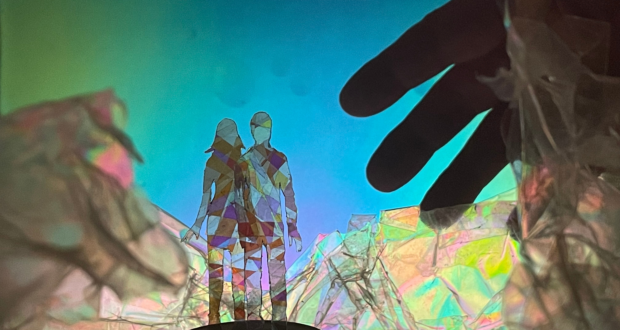A clever, complex work integrating live performance with cinema, occupying a peculiar middle space in theatre.Summary
Rating
Good
As part of MimeLondon, French company Stereoptik come to the Barbican Pit with Antechamber, a crossover theatre/live animation/film piece. As we enter the room a huge projection screen faces us from the back wall and we see creatives Romain Bermond and Jean-Baptiste Maillet sit up further forward at technological workbenches, with an assortment of media and devices.
As the show begins, a fly buzzes in stereophonic sound, traversing the space and exploring it: a suggestion of what is to come. This is a non-verbal performance, so we’re told by onscreen projection that it involves “creative research”, and that very much sums up what is presented, as images, perspectives, artforms and ideas combine, starting small before opening up into big thinking. We meet a young man who rediscovers a photograph from his youth that reconnects him with his childhood and makes him think differently about his world.
There’s a complex mix of live performances that includes puppetry, painting and music, largely done in real time and integrated into a unique live animation on the screen. Maillet supplies dynamic music, looping drums, keyboards, percussion, to create a visceral, resonant and sensory input that is layered with a recorded soundtrack and makes the room pulse with energy. Meanwhile, at Bermond’s workstation tiny figures, puppets and actions are filmed at close quarters but viewed at scale, with the images and sound blending to create shifting atmospheres and environments, and transparent human forms reinterpreted using light.
This evocative work plays with multiple themes; of love, nature, the inside and outside, memory. Within the fluxing process there’s a huge range of materials to be identified and reimagined, and the performance transforms them as they explore the man’s world, interactions with other people, the urban environment and wider ecological landscapes, such as the Amazon.
The context of animation sits comfortably with ideas of what it is to be alive, and the realities of our existence. Human hands are seen to be integral in literally creating or destroying realities, crumpling up art after drawing it – also a reminder that this performance is unique and ephemeral. Dreams, fact, and agency to make change are all embodied in the kaleidoscopic images, enabling us to observe with new perspectives and become active participants in visualising our world in different forms and spaces, just as the man negotiates his.
There are some fascinating, innovative moments. Magnets and puppets are used to bring objects and images alive across visual layers, while live painting sees pictures building, perspectives shifting, before the image becomes 3D when solid models are added into the space.
The second part of the show transitions into Le Film, which sees the performers leave the stage and their creations perform without them. As the man reads about the Amazon, dreamlike we’re also taken beyond the room, to fly with parakeets and butterflies, and laugh at cheeky monkeys.
Much as this is a thoroughly fascinating and carefully constructed production, the hybrid format creates complication. With so many interesting things being actively produced before me, I was craning to see the practical processes being undertaken. However, my attention was relentlessly drawn back to the big screen, where the manual art was digitally redescribed into another form, filtering out something of the liveness of the performance, and in film it perhaps mattered less to me how the images had got there. I felt a little frustrated by this, as if the show was describing the generation of agency, whilst simultaneously pushing me to view in a particular way. However, what I did view was fascinating, stimulating, and beautifully crafted in its exploration.
Written, directed, and produced by Jean-Baptiste Maillet and Romain Bermond
Antechamber plays as part of MimeLondon at Barbican Centre until 3 February. Further information and bookings can be found here.
 Everything Theatre Reviews, interviews and news for theatre lovers, London and beyond
Everything Theatre Reviews, interviews and news for theatre lovers, London and beyond



